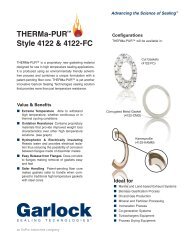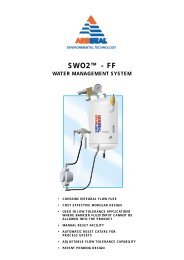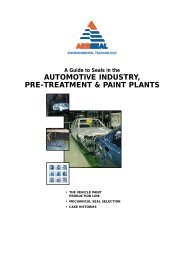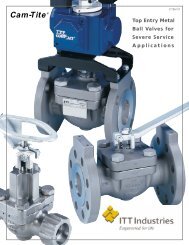expansion joints - AR Thomson Group
expansion joints - AR Thomson Group
expansion joints - AR Thomson Group
Create successful ePaper yourself
Turn your PDF publications into a flip-book with our unique Google optimized e-Paper software.
LIFE EXPECTANCY OF ELASTOMERIC JOINTS<br />
The life expectancy of an elastomeric <strong>expansion</strong><br />
joint is based on many factors.<br />
1. Service Conditions<br />
a. Temperature<br />
b. Pressure<br />
c. Movement<br />
d. Number of Cycles<br />
e. Environmental Conditions<br />
f. Media - Abrasive, Chemical<br />
g. Flow Rate<br />
2. Presence of Misalignment<br />
3. Proper Installation<br />
4. Proper Storage<br />
If the service conditions are not severe, no misalignment<br />
is present, the <strong>expansion</strong> <strong>joints</strong> are stored<br />
and installed properly, the estimated life expectancy of<br />
an elastomeric <strong>expansion</strong> joint is approximately five<br />
years.<br />
As stated in this manual, if, however, <strong>expansion</strong><br />
<strong>joints</strong> are subjected to harsh service conditions, severe<br />
misalignment, installed or stored improperly or anycombination<br />
thereof, this predicted life will decrease<br />
proportionately.<br />
Storage Instructions<br />
In order to obtain complete shelf life, elastomeric<br />
<strong>expansion</strong> <strong>joints</strong> must be stored properly.<br />
1. Store in a cool, dry area.<br />
2. Store Iying on one flange face.<br />
3. Protect the flange faces and tube from nicks,<br />
cuts, dents, etc.<br />
4. Do not expose to greases, oils or solvents in<br />
liquid or vapor form.<br />
5. Prevent exposure to ultraviolet (UV) light from<br />
sunlight or strong fluorescent lights.<br />
6. Do not store near devices which produce<br />
ozone (O3).<br />
7. Do not place other objects on the top flange of<br />
the <strong>expansion</strong> joint.<br />
8. Following extended storage, C<strong>AR</strong>EFULLY<br />
inspect the joint for damage.<br />
9. If in doubt concerning any of the above<br />
provisions, consult the manufacturer.<br />
Shelf Life<br />
Based on ideal storage conditions, the shelf life of<br />
an elastomeric <strong>expansion</strong> joint is five years from the<br />
date of manufacture.<br />
If this time period is exceeded, some degenerative<br />
processes may take place; i.e. embrittlement, cracking,<br />
restriction of movement capabilities, etc.<br />
Should <strong>expansion</strong> <strong>joints</strong> be stored at less than<br />
ideal conditions, this five year shelf life must be<br />
reduced proportionately. (See storage instructions.)<br />
Shelf life mustbe taken into consideration when predicting<br />
the life expectancy of elastomeric <strong>expansion</strong> <strong>joints</strong><br />
– if stored in less than ideal conditions, the expected<br />
service life would decrease accordingly.<br />
Replacement Schedule<br />
Since the typical life expectancy of an elastomeric<br />
<strong>expansion</strong> joint is five years, preventive maintenance<br />
schedules should be enacted accordingly.<br />
If, however, excessive misalignment is present,<br />
causing the <strong>expansion</strong> joint to undergo significant<br />
stress, this schedule must be adjusted.<br />
When the <strong>expansion</strong> <strong>joints</strong> are subjected to<br />
extreme or harsh conditions, i.e. high pressure, excessive<br />
movement/cycling, abrasion, etc., inspection procedures<br />
need to be done at more timely intervals,<br />
beginning at the end of the first year in service and<br />
continuing on an ongoing basis. If the service is critical,<br />
an accelerated inspection schedule is suggested.<br />
If the <strong>expansion</strong> joint demonstrates signs of fatigue,<br />
replace it as soon as possible. If no physical/visible<br />
signs of distress are present, the <strong>expansion</strong> joint<br />
should be replaced every five years. The strength of<br />
the <strong>expansion</strong> joint is in the internal structuring of its<br />
layers; deterioration of these strengthening plies is not<br />
always apparent.<br />
15




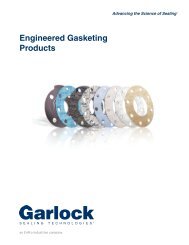
![VCS Flange Gasket [1.03 MB] - AR Thomson Group](https://img.yumpu.com/12044617/1/190x245/vcs-flange-gasket-103-mb-ar-thomson-group.jpg?quality=85)

![PGE Flange Gasket Product Brochure [1.04 MB] - AR Thomson Group](https://img.yumpu.com/12044595/1/190x245/pge-flange-gasket-product-brochure-104-mb-ar-thomson-group.jpg?quality=85)
